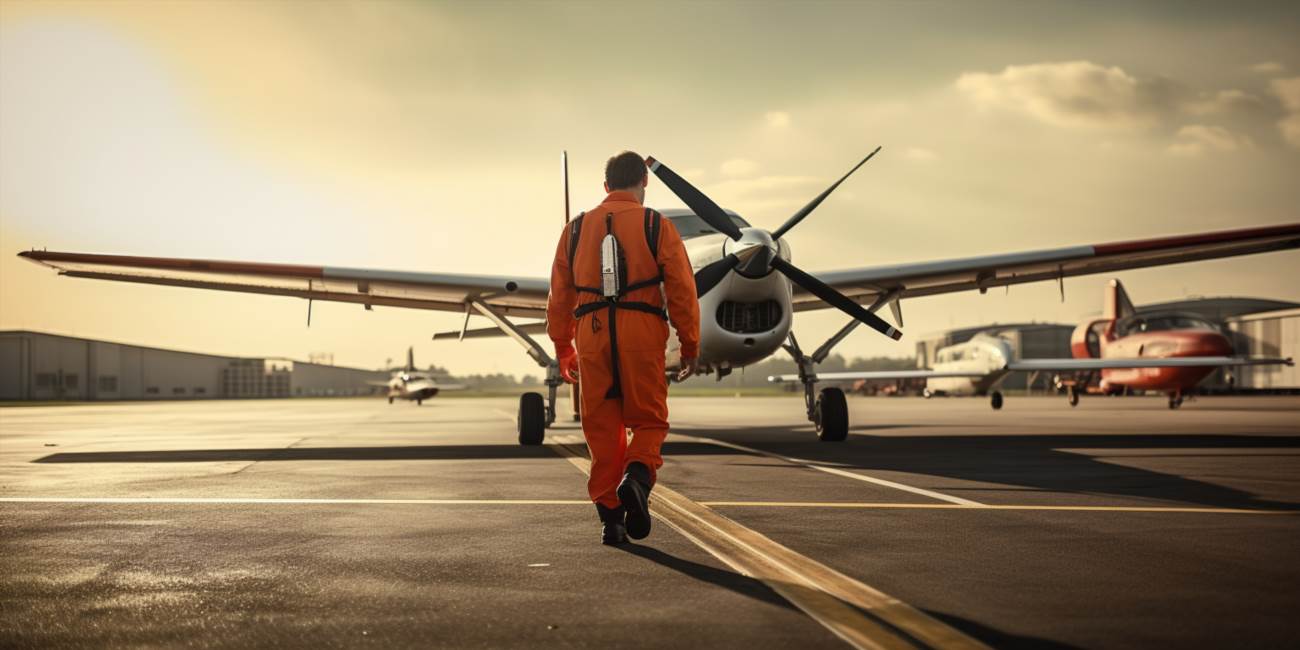One fundamental aspect of calculating aircraft weight and balance involves determining the aircraft’s empty weight, which includes the weight of the airframe, engines, and all permanently installed equipment. This serves as the baseline for subsequent calculations.
The next step is to account for the weight of the fuel. Fuel weight is a dynamic factor that changes during flight, and its distribution significantly impacts the aircraft’s center of gravity (CG). Pilots use CG limits to ensure the aircraft remains within a stable configuration, preventing the risk of uncontrollable flight.
Baggage and cargo also play a crucial role in the overall weight and balance calculation. Each piece of luggage or cargo item contributes to the total weight, and its position in the aircraft affects the CG. It’s vital to distribute these loads evenly to avoid an imbalanced aircraft, which could compromise control.
Calculating the arm of each component is another key step. The arm represents the horizontal distance from the reference datum to the center of gravity of an item. Multiplying the weight of each component by its arm allows pilots to determine the moment, which is a measure of the force causing the aircraft to rotate about its CG.
Now, let’s delve into the specifics of the calculations. The basic formula for weight and balance is:
| Item | Weight (lbs) | Arm (inches) | Moment (lb-in) |
|---|---|---|---|
| Airframe | W1 | Arm1 | W1 x Arm1 |
| Engines | W2 | Arm2 | W2 x Arm2 |
| Fuel | W3 | Arm3 | W3 x Arm3 |
| Baggage/Cargo | W4 | Arm4 | W4 x Arm4 |
The total moment is the sum of all individual moments. To find the CG, divide the total moment by the total weight: CG = (Total Moment) / (Total Weight).
Performing these calculations accurately ensures that the aircraft remains within its specified weight and balance limits. Pilots and ground crews must collaborate to update these calculations based on changes in payload, fuel consumption, or other factors influencing the aircraft’s weight distribution.
Necessary steps for accurate weight and balance calculation
Accurate weight and balance calculation is crucial for the safe operation of any aircraft. Ensuring that an aircraft is within its specified weight and balance limits is essential for maintaining stability and maneuverability during flight. Here are the necessary steps to achieve accurate weight and balance calculations:
1. Determine Basic Empty Weight: Start by obtaining the Basic Empty Weight (BEW) of the aircraft. This includes the weight of the aircraft structure, systems, and any permanently installed equipment. Refer to the aircraft’s weight and balance manual for this information.
2. Add Weight of Fuel: Include the weight of the fuel in the calculation. Take into account both usable and unusable fuel. It’s crucial to use the correct fuel density for accurate calculations. Remember that fuel weight changes as it is consumed during the flight.
3. Consider Crew and Passenger Weights: Factor in the weights of the crew and passengers. Use actual weights rather than standard values for a more precise calculation. Keep in mind that individuals’ weights can vary, so it’s important to obtain the most up-to-date information.
4. Include Cargo and Baggage: Account for the weight of cargo and baggage items. This includes both checked and carry-on baggage. Be meticulous in weighing each item to ensure accuracy. Remember to consider the placement of cargo to distribute the weight evenly.
5. Determine Arm and Moment for Each Component: Calculate the arm (distance from the reference point) and moment (product of weight and arm) for each component in the weight and balance calculation. This step is critical for assessing the distribution of weight throughout the aircraft.
6. Sum Up the Weights and Moments: Sum up the weights and moments for all components to obtain the total weight and moment of the aircraft. This information is used to calculate the aircraft’s center of gravity (CG).
7. Calculate Center of Gravity (CG): Use the total weight and moment values to compute the Center of Gravity (CG) of the aircraft. Ensure that the CG falls within the specified limits outlined in the aircraft’s performance documentation. A proper CG is vital for stable flight characteristics.
8. Cross-Check with Manuals: Cross-reference your calculated values with the aircraft’s weight and balance manual and any other relevant documentation. Ensure that your calculations align with the manufacturer’s specifications.
9. Update Data Regularly: Weight and balance considerations are dynamic, and changes can occur over time. Regularly update the weight and balance data to reflect modifications, equipment additions, or any other changes that may affect the aircraft’s weight distribution.
By diligently following these steps, pilots and ground crews can contribute to the overall safety and performance of an aircraft by maintaining accurate weight and balance calculations.
What are the essential weight and balance documents

Understanding the essential weight and balance documents is paramount in aviation to ensure the safety and efficiency of flights. Pilots and ground crew rely on these documents to make critical decisions about loading and distributing weight within an aircraft.
One fundamental parameter in these documents is the basic empty weight, denoted as the weight of the aircraft when it is without occupants, fuel, or payload. This value serves as a starting point for calculating the aircraft’s overall weight and influences the distribution of additional loads.
The useful load is another key factor in weight and balance considerations. It represents the maximum allowable weight of passengers, cargo, and fuel that an aircraft can carry while remaining within specified limits. The interplay between the basic empty weight and useful load determines the aircraft’s capacity and operational capabilities.
Additionally, moment limits play a crucial role in maintaining proper weight distribution. Moments are calculated by multiplying the weight of an item by its distance from a reference point. Ensuring that the total moments remain within specified limits is essential for stability and control during flight.
For a comprehensive overview, consider the following table:
| Document | Definition |
|---|---|
| Essential Weight and Balance Documents | Crucial documents guiding weight distribution decisions for safe flight operations. |
| Basic Empty Weight | Weight of the aircraft without occupants, fuel, or payload. |
| Useful Load | Maximum allowable weight of passengers, cargo, and fuel. |
| Moment Limits | Specified limits on the calculated moments to ensure proper weight distribution. |
These parameters are interrelated and form the foundation for precise weight and balance calculations, contributing to the overall safety and performance of an aircraft.
Why is weight and balance so important when operating aircraft
Operating an aircraft is a complex task that demands meticulous attention to detail, and one of the critical aspects that pilots and aviation professionals cannot afford to overlook is the weight and balance of the aircraft. This seemingly mundane factor plays a pivotal role in ensuring flight safety, optimizing aircraft performance, and ultimately working to avoid accidents.
Imagine an aircraft as a delicate equilibrium, where the distribution of weight is not just a matter of convenience but a crucial determinant of the overall safety of the flight. When discussing flight safety, the weight and balance of an aircraft become non-negotiable factors. Deviating from the prescribed weight and balance parameters can lead to disastrous consequences, compromising the stability of the aircraft and putting the lives of passengers and crew at risk.
The impact of weight and balance on aircraft performance is profound. An aircraft that is not correctly balanced may experience difficulties in maneuvering, affecting its ability to respond effectively to various flight conditions. Aircraft performance is not solely about speed and altitude; it encompasses the overall responsiveness and agility of the aircraft, both of which are intricately tied to how the weight is distributed.
To comprehend the significance of avoiding accidents, one must delve into the role that weight and balance play in mitigating risks. Incorrectly loaded cargo or an uneven distribution of passengers can lead to an imbalance that might result in a loss of control during takeoff or landing. The correlation between proper weight and balance and avoiding accidents is evident in the meticulous pre-flight checks that pilots conduct, ensuring that the aircraft is within the specified limits for a safe and uneventful journey.
Let’s break down the intricacies of flight safety, aircraft performance, and the imperative need to avoid accidents through the lens of weight and balance. Ensuring that the center of gravity is within the defined parameters, and the weight is distributed evenly, forms the bedrock of flight safety. Pilots rely on this foundational principle to navigate through the skies with confidence, knowing that their aircraft is in an optimal state for safe operation.
Consider aircraft performance as a symphony where each instrument must harmonize for a flawless composition. In this analogy, weight and balance take center stage, dictating the aircraft’s ability to climb, turn, and descend seamlessly. A well-maintained weight and balance profile translates into enhanced aircraft performance, allowing pilots to push the boundaries of efficiency and responsiveness.
Lastly, the commitment to avoid accidents is a shared responsibility among aviation professionals. The careful consideration of weight and balance serves as a preventive measure, a proactive stance against potential mishaps. By recognizing the integral role of weight and balance in flight safety and aircraft performance, the aviation community collectively works towards a future where accidents are not just mitigated but largely eliminated.






